Research Achievement
2023
본 연구에서 제2세부과제의 핵심과제로 장기간에 걸쳐 연구한 사각격자 이리듐 산화물에서 공명 엑스선 산란과 라만 사란을 이용하여 스핀 사극자의 존재를 확인하였다. 네마틱이랑 고체와 액체의 성질을 동시에 가지는 물질상으로 스핀계에서도 유사한 상태가 존재할 것이라는 이론적인 예측이 반세기전에 있었지만 본 연구에서 세계최초로 그 존재가 실험적으로 확인되었다. 저온 반강자성 상태에서 스핀 쌍극자와 사극자가 동시에 존재함을 엑스선 산란의 간섭을 이용하여 스핀 성분 및 공간 분포 형태를 완전히 해독하였다. 이를 바탕으로 라만 산란을 이전에 수행되지 않은 편광 채널에서 측정함으로써 스핀 쌍극자가 사라지는 임계 온도에서 스핀사극자가 단독으로 살아남는 것을 확인하여 스핀 네마틱 상의 존재를 직접적으로 확인하였다. 이로써 사각격자 이리듐 산화물의 pseudogap 상태에서 숨은 질서의 존재를 처음으로 확인하였다.
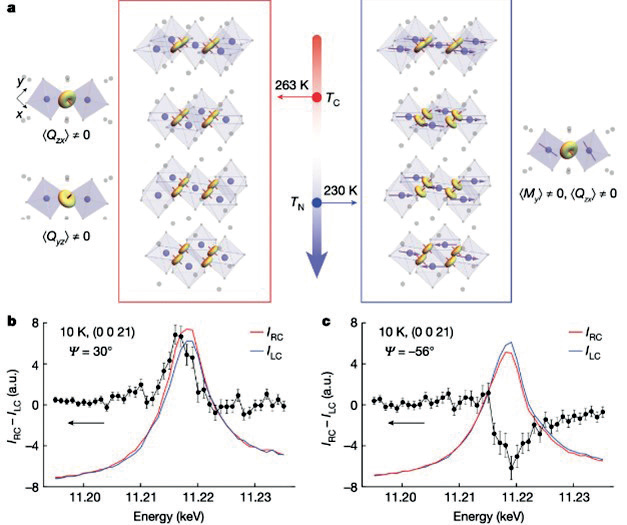
Figure. (a) Schematic of spin nematic and antiferromagnetic orders. (b) Circular dichroism due to interference of scattering amplitudes between spin dipoles and quadrupoles at low temperatures.
In this study, We have confirmed the existence of spin quadrupoles in square lattice iridium oxides using resonant X-ray scattering and Raman scattering, which has been researched over a long period. Nematic, a state that simultaneously possesses the properties of both solids and liquids, had been theoretically predicted to exist in spin systems half a century ago, but its existence was experimentally confirmed for the first time in this study. At low temperatures in the canted antiferromagnetic state, the coexistence of spin dipoles and quadrupoles was fully deciphered using the interference of X-ray scattering in terms of spin component and spatial distribution. Based on this, by measuring Raman scattering in previously unexplored polarization channels, we directly confirmed the existence of the spin nematic phase by observing that spin quadrupoles survive alone at the critical temperature where spin dipoles disappear. Thus, for the first time, we have confirmed the presence of hidden order in the pseudogap state of square lattice iridium oxides.
본 연구에서는 기존에 장기간에 걸쳐 진행하고 있는 연구단의 핵심연구주제인 일차원 전자계의 솔리톤연구에 있어서 중요한 새로운 발견을 보고하였다. 해당 연구에서는 본 연구단이 2015년 Science에 발표한 바와 같이 Z4 대칭성을 가지는 카이럴 솔리톤들이 솔리톤간의 상호작용을 통하여 분자형태로 결합된 새로운 형태의 위상여기를 주사터널현미경 실험을 통하여 발견하였다. 위 그림에서 보듯, 솔리톤 분자는 서로 반대방향의 카이럴 성질을 가지는 분자간의 결합으로 두 번의 180도 위상차가 더해져 전체의 위상치를 0으로 만든다. 전자구조적으로는 밴드갭내의 솔리톤 전자상태간의 분자결합이 만들어져, 새로운 전자상태를 구성함을 실험과 이론으로 확인하였다. 솔리톤 분자는 솔리톤간에 인력이 존재하는 경우 만들어질 수 있음이 오랫동안 예측되어 왔고 광학계에서의 솔리톤에서 발견된 바가 있다. 하지만 전자계의 솔리톤간의 분자적 결합은 이번 연구에서 세계최초로 확인되었다. 솔리톤 분자는 솔리톤간의 상호작용 연구라는 새로운 연구영역을 개척한 성과이며 동시에 솔리톤 여기의 종류가 확장되어 정보전달체로서의 솔리톤의 응용에 여러 가지 도움을 줄 수 있다.
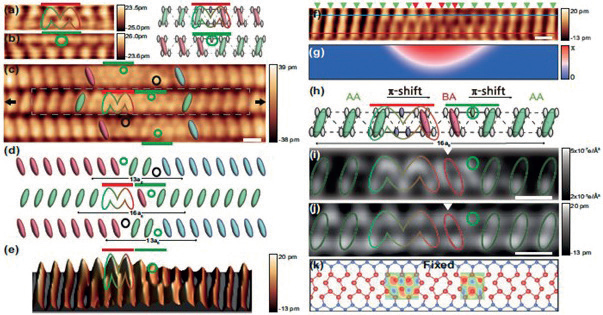
Figure. (Left) STM topography for a soliton molecule (in the central chain of (c)), which is composed of two solitons of different types. (Right) Cancelation of the phase shifts of two component solitons within a soliton molecule and its atomic structure.
Soliton molecules, bound states of two solitons, can be important for the informatics using solitons and the quest for exotic particles in a wide range of physical systems from unconventional superconductors to nuclear matter and Higgs field, but have been observed only in temporal dimension for classical wave optical systems. Here, we identify a topological soliton molecule formed spatially in an electronic system,a quasi 1D charge density wave of indium atomic wires. This system is composed of two coupled Peierls chains, which are endowed with a Z4 topology and three distinct, right-chiral, left-chiral, and non-chiral,topology and three distinct, right-chiral, left-chiral, and non-chiral, solitons. Our scanning tunneling microscopy measurements identify a bound state of right- and left-chiral solitons with distinct in-gap states and net zero phase shift. Our density functional theory calculations reveal the attractive interaction of these solitons and the hybridization of their electronic states. This result initiates the study of the interaction between solitons in electronic systems, which can provide novel manybody electronic states and extra data-handling capacity beyond the given soliton topology.
본 연구에서는 연구단의 핵심연구주제라 할 수 있는 위상학적 페르미온의 특성 에 대한 결과를 담고 있다. 비틀린 이중층 그래핀은 극저온에서 평평한 전자구조, 위상학적 특징을 가진 전자의 파동함수, 그리고 강한 상호작용을 가진 것으로 잘 알려져 있다. 강한 전자 간의 상호 작용은 두 그래핀 층 사이에 엑시톤 형성에 최 적의 환경을 제시하고 있다는 점에 착안, 본 연구진은 강한 자기장이 가해진 상황 에서 기존 GaAs/GaAsAl 연구 결과 대비 10-100배 높은 온도에서 엑시톤 응축 현상이 나타날 수 있음을 이론과 실험 공동연구를 통해 보였다. 특히, 자기장과 더 불어 그래핀 층 사이에 전기장이 주어진 경우, 다양한 대칭성 붕괴 패턴을 조절할 수 있음을 보였다. 이러한 연구 결과는 고온에서 엑시톤 응축 현상의 발현 가능성 을 보임과 동시에 자기장/전기장을 이용하여 위상학적 페르미온의 위상특성을 조 작할 수 있는 방법을 제안하고 있다. 또한 장차 그래핀을 넘어서서 다양한 2차원 반데르발스 물질의 전기적/위상학적 물성을 조작하는 방법 개발에 이론적 기반을 제공할 것으로 보인다.
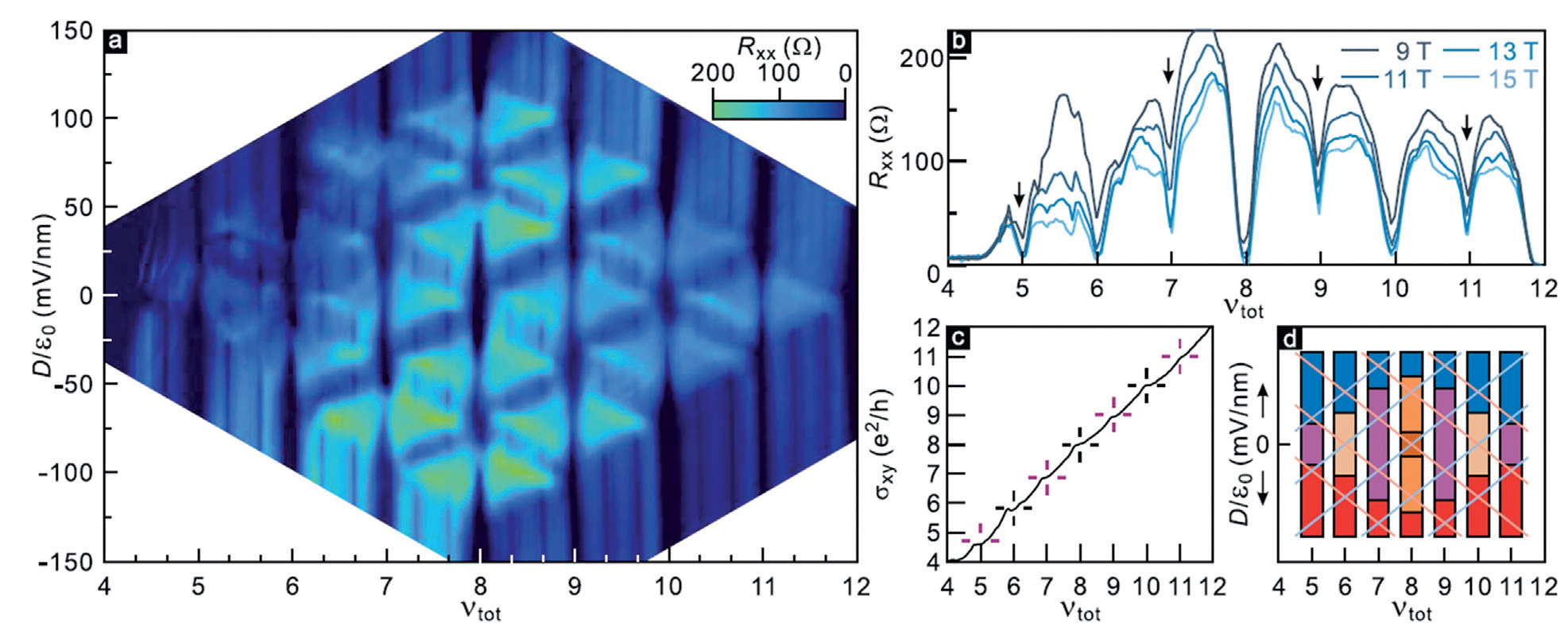
Figure. Longitudinal resistance (color plot) of the twisted bilayer graphene in terms of the displacement fields (y-axis) and the filling (x-axis). The stable quantum Hall states manifest as the zero resistance states in the plot. There is a sequence of the quantum Hall states at the zero displacement fields, which correspond to the interlayer-coherent exciton condensed states. (b) The longitudinal resistance at the zero displacement fields as the magnetic field varies. (c) The Hall conductance at the vanishing displacement field in terms of the filling (x-axis). The stable quantum Hall states manifest both in (b) and (c). (d) Theoretical phase diagram explains well the experimental data (a).
This research considers the realization of the topological fermions in a two-dimensional device made of the large-angle twisted bilayer graphene. The twisted bilayer graphene is well known for its flat bands, correlation effects, and topology, which all intertwine to give rise non-trivial phenomenon. In this study, we utilize the ultra-strong interlayer Coulomb interactions to stabilize the exciton condensate and found that the condensation occurs at the temperature which is one or two orders of magnitudes higher than those of the GaAsAl/GaAs quantum wells. Furthermore, we successfully demonstrated that the displacement fields can be used to control the symmetry breaking patterns in this device. Our topological fermions in the two-dimensional devices, using the strong magnetic fields and displacement fields.
본 연구에서는 기존에 장기간에 걸쳐 진행하고 있는 연구단의 핵심연구주제인 일차원 전자계의 솔리톤연구에 있어서 중요한 새로운 발견을 보고하였다. 기존 1D atomic chain 과는 다르게 Strong correlation 효과가 있는 2D Van der Waals 시스템인 1T-TaS2 표면에서 charge density wave 에 의한 두 도메인의 위상차이로 발생하는 1D domain wall에서 발현하는 mobile kink soliton을 발견하였다. 본 연구에서는 STM 측정을 통하여 doman wall 의 kink 구조를 규명하였으며, 저온에서도 확산되는 kink soliton 의 거동을 직접 확인하였다. 또한, kink soliton 에 의해 발현하는 전자구조에 대한 이론적인 해석과 더불어 위상학적인 성질을 규명하였다. 본 연구는 기존 1D soliton 의 개념을 2D로 확장하는데 중요한 기여를 하였으며, 더불어 correlation 효과에 의한 spin order로 향후의 솔리톤의 응용에 다양성을 제공한다.
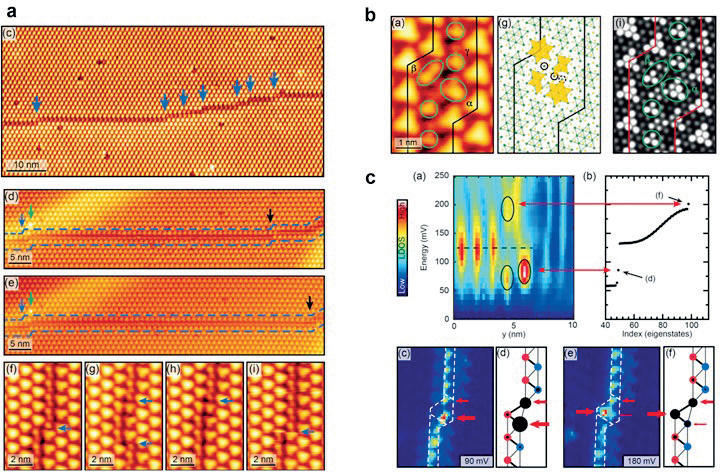
Figure. Mobile kink soliton on domain wall of 1T-TaS2. (a) STM images of the kink soliton.(b) Atomic structure and simulated STM image. (c) Electronic structure of the kink including experimental STS line profile, dI/dV maps and theoretical tight-binding results.
In this work, we report a significant breakthrough in the study of solitons in correlated 2D charge density wave systems. We discovered mobile kink solitons on 1D phase-shift domain walls in the charge density wave phase of 1T-TaS2. Using STM measurements, we elucidated the kink structure and directly observed the behavior of the kink soliton diffusing even at low temperatures. Additionally, we identified the electronic structure induced by the kink soliton and its topological properties through theoretical analysis. This research extends the concept of 1D solitons to 2D, offering diverse possibilities for future soliton applications due to the spin order resulting from correlation effects.
일차원전자계에서 전자-전자상호작용에 의해 발생하는 비페르미액체현상, 즉 Tomonaga-Luttinger 액체 현상은 저차원 전자계의 중요한 물성으로 다양한 물질계에서 발현된다. 그러나 특히 일차원계에서는 불순물에 매우 민감하고 불순물들에 의한 영향과 구별하기 어려워 실제로 발견하기가 어렵다. 본 연구에서는 새롭게 발견된 반데르발스 Nb9Si4Te18 물질의 일차원적 디락밴드구조에 주목하여 Tomonaga-Luttinger 액체 현상의 발현을 검증하려하였다. 해당 물질의 디락전자계에 대한 주사터널현미경 분광실험을 실시한 결과, 페르미준위 주면에 강하게 전자밀도가 줄어드는 현상을 발견하였고, 이러한 현상을 정량적으로 측정한 결과 Tomonaga-Luttinger 액체 현상의 주요한 지표인 power-law 거동임을 밝힐 수 있었다. 아울러 이러한 power-law 거동이 불순물과 관계없이 나타나는 새로운 현상이 발견되었다. 본 연구에서은 이러한 현상이 일차원적인 디락밴드에서 나타나는 특이성, 즉 전자의 후방산란이 억제되는 디락전자의 특이성에 기인 한다고 해석하고 있다. 이러한 결과를 통하여 반데르발스물질계에서도 일차원전자의 상호작용을 연구할 수 있으며 디락밴드를 가지는 일차원전자계가 특이 거동을 보임을 밝힐 수 있어, 향후 반데르발스 물질계를 일차원전자계 연구에 활용하는 것이 가능해졌다.
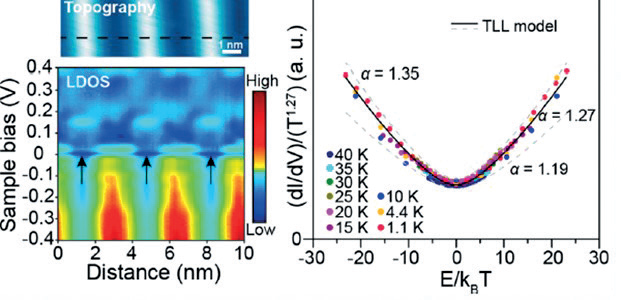
Figure. (Left) Topography and spectroscopy maps by STM of a Nb9Si4Te18 crystal showing the local density of state near the Fermi energy suppressed along the Nb chain structure (arrows). (Right) The suppression of the density of states around the Fermi energy is independent of temperature and is scaled well into the prediction of the Tomonaga-Luttinger Liquid theory
We report on the Tomonaga-Luttinger liquid (TLL) behavior in fully degenerate 1D Dirac Fermions. A ternary van der Waals material Nb9Si4Te18 incorporates in-plane NbTe2 chains, which produce a 1D Dirac band crossing Fermi energy. Tunneling conductance of electrons confined within NbTe2 chains is found to be substantially suppressed at Fermi energy, which follows a power law with a universal temperature scaling, hallmarking a TLL state. The obtained Luttinger parameter of ∼0.15 indicates a strong electron-electron interaction. The TLL behavior is found to be robust against atomic-scale defects, which might be related to the Dirac electron nature. These findings, combined with the tunability of the compound and the merit of a van der Waals material, offer a robust, tunable, and integrable platform to exploit non-Fermi liquid physics.
본 연구단은 3D 고자장 자석을 탑재한 초저온 주사 터널링 현미경을 이용하여 전자 온도 70 mK라는 세계 최고 수준의 고에너지 분해능 성능을 확보하였다. 이를 위해 다양한 샘플 처리 과정을 최적화하여 본격적인 실험을 수행하였으며, 2024년 초부터 밀리켈빈 온도에서 광범위한 실험을 진행해 오고 있다.
초기에는 다결정 알루미늄막을 사용하였으나, 초고진공 상태에서 스퍼터링 및 어닐링을 통해 NiAl(110) 및 Al(111)과 같은 원자적으로 깨끗한 단결정 기판을 준비하는 방식으로 전환하였다. 또한, 스핀 관련 연구를 위한 격리층으로 사용하기 위해 NiAl(110) 및 CoAl(100) 기판 위에 약 6 옹스트롬 두께의 산화막 패치를 성장시켰다.
본 장비는 실험 범위를 확장하기 위해 저온 증착 능력을 향상시켰다. 또한, 샘플 및 스캐너를 액체 질소로 90 K, 액체 헬륨으로 60 K까지 냉각하는 전처리냉각과정을 개발하였다. 이 전처리냉각과정은 샘플이 운송 중에 오염되는 것을 방지하기 위해서 필수적이다.
추가적으로, 탐침의 위치를 거시적으로 움직이기 위한 새로운 주사 터널링 현미경 헤드를 개발하고, 샘플 홀더를 진공 챔버로 한 시간 이내에 전송할 수 있는 로드락 챔버 시스템을 고안하였다. 2024년 초, 클리빙하여 준비할 수 있는 반데르발스 물질에 대한 광범위한 측정을 수행하였다. 그림 6은 밀리켈빈 온도에서의 이황화탄탈럼(TaS2)의 지형을 보여준다. 새로운 측정을 통해 TaS2에서 제로바이어스 근처의 V형 유사갭을 확인했으며 (그림 6), 이는 무거운 페르미온 또는 콘도 효과와 관련이 있을 것으로 보고 있다.
기능을 더욱 향상시키기 위해 샘플을 준비하는 챔버 온도를 40 K 이하로 낮추는 것을 목표로 하고 있다. 이를 통해 금속 원자나 분자를 얇은 산화막 또는 다른 격리층 위에 안정적으로 증착할 수 있게 될 것이다. 이러한 기능이 확보되면 본 장비는 극저온주사터널 현미경에서 측정가능한 거의 모든 실험영역에서 측정이 가능한 세계 최고 수준의 강력한 연구 장비가 될 것이다.
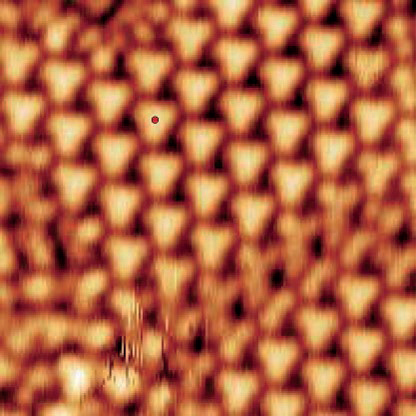
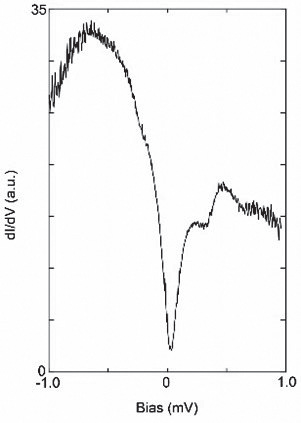
Figure. Topography of TaS2 and dI/dV spectroscopy at the red dot of left image. Topography image size is 10 nm x 10 nm.
In early 2023, our ultra-low temperature scanning tunneling microscope with a 3D high-field magnet achieved the world’s highest energy resolution, characterized by an electron temperrature of 70mK. We optimized various sample processes to conduct full-scale experiments, and since then, we have been conducting extensive experiments at millikelvinvan temperatures. We transitioned from using polycrystalline aluminum foil to preparing atomically clean single-crystal substrates like NiAl(110) and Al(111) through sputtering and annealing in ultra-high vacuum. We also grew oxide patches approximately 6 angstroms thick on NiAl(110) and CoAl(100) substrates for use as isolation layers in spin-related studies.
To expand the experimental range of the millikelvin scanning tunneling microscope, we enhanced low-temperature deposition capabilities. We developed a scanner manipulator for pre-cooling, achieving sample and scanner cooling to 90 K with liquid nitrogen and 60 K with liquid helium. This pre-cooling system is essential to prevent sample contamination during transport to the low-temperature receptacle. Furthermore, we developed a new scanning tunneling microscope head with coarse probe motion and devised a load-lock chamber system for transferring sample holders into the vacuum chamber within an hour.
We conducted extensive measurements on van der Waals materials that can be prepared by cleaving. Figure 6 shows the topography of tantalum sulfide (TaS2) at milli-Kelvin temperatures. We newly measured the V-shaped pseudo-gap near zero bias in TaS2 (Figure 6). This feature may be related to heavy fermions or the Kondo effect.
To further improve functionality, we aim to reduce the sample preparation chamber temperature to below 40 K, enabling stable deposition of metal atoms or molecules on thin oxide films or other separating layers. This enhancement will make our equipment a world-class scanning tunneling microscope for ultra-low temperature experiments.
Synchrotron ARPES를 활용하여 다양한 2차원 전이금속 캘코저나이드 및 카고메 물질군에 대한 전자구조 및 새로운 물질상을 발현하는 연구들을 수행하였다. 아래 그림에 대표적인 몇 가지 연구 결과를 나타내었다. 1T-TiSe2는 전하밀도파 현상과 초전도 현상이 경쟁하는 것으로 잘 알려져 있는 물질로, real-time ARPES 측정을 통해 특정 밴드에 대해 선택적으로 전하 투입이 발생하고 전하밀도파가 유지됨을 확인하였다. 이 전하밀도파는 열처리를 통해 용해됨을 확인하였다. Nb3TeI7은 Nb 이온이 변형된 카고메 격자 구조를 가진 물질로 ARPES측정을 통해 양쪽 면의 전자구조가 상이한 Janus 물질임을 확인하였다. 또한, real-time XPS 측정을 통해 전하투입이 한쪽 면에서만 이루어지는 현상을 관측함으로써 Janus 구조에 의해 양극성을 가진다는 것을 보였다.
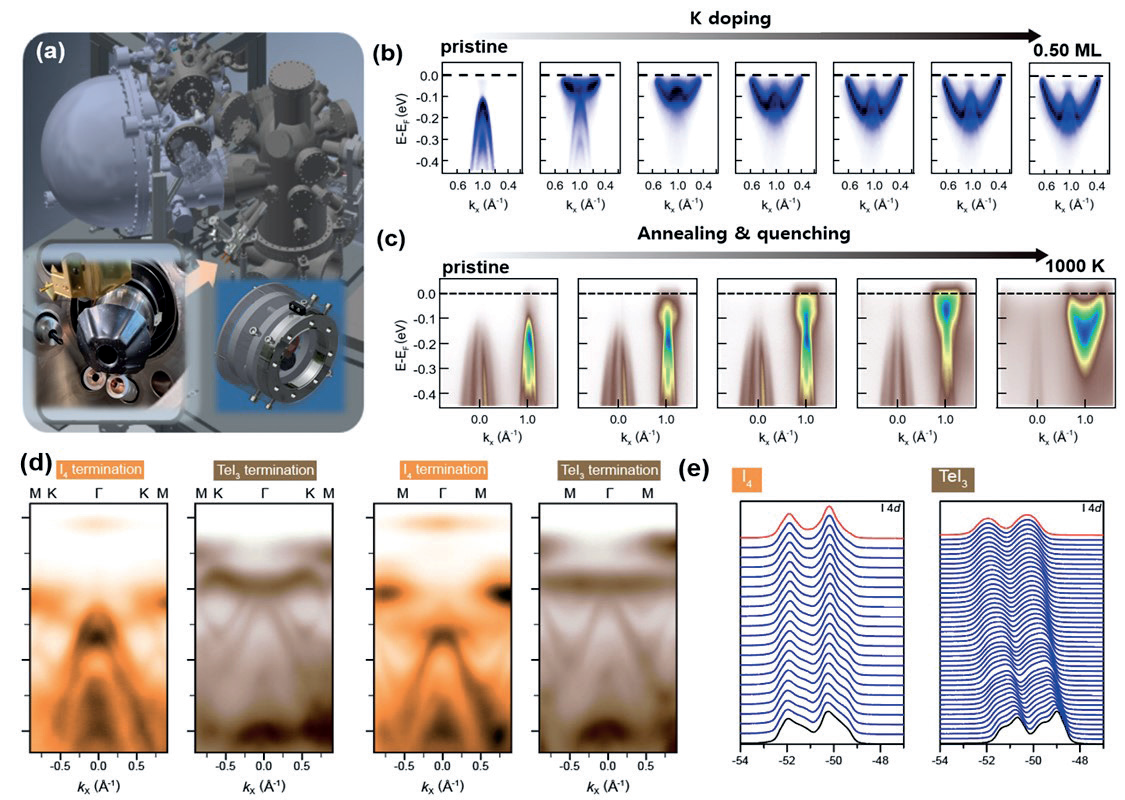
Figure. (a) Analysis chamber of CALDES spin ARPES at PLS-II. Real-time ARPES while charge dosing and laser heating is available. (b) 1T-TiSe2: The evolution of band structure as charge dosing captured with real-time ARPES (c) 1T-TiSe2:CDW melting by a thermal process (d),(e) Nb3TeI7: Ambipolar electronic structures observed in ARPES and core-level XPS.
A few of transition metal chalcogenides and Kagome materials have been intensively studied at the CALDES spin-ARPES end station in PLS-II. 1T-TiSe2 is a well-known low dimensional material with an exotic charge density wave (CDW), which competes with the superconductivity. We have clearly observed a novel band-selective dosing and the consistent CDW with real-time ARPES. Nb3TeI7 is a Kagome material with lowered symmetry by breathing. We have successfully observed distinct electronic structures at both sides and through the real-time XPS measurement, it is confirmed to have a large ambipolarity, invaluable property to realize vdW diodes and transistors.
 Center for Artificial Low
Center for Artificial Low